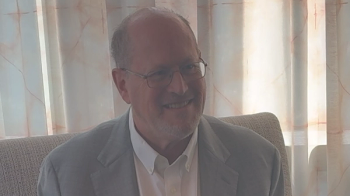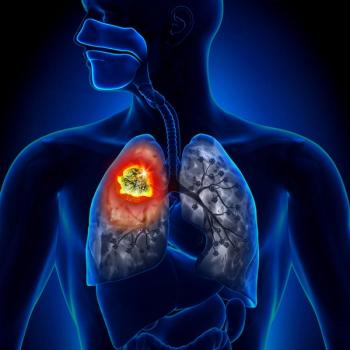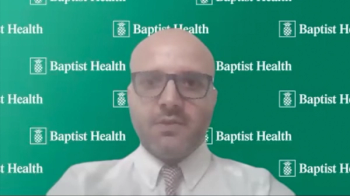
SBRT Provides Positive Locoregional Control in Lung Neuroendocrine Tumors
Data from a retrospective study suggests that stereotactic body radiotherapy may be a suitable alternative to surgical resection for patients with primary lung neuroendocrine tumors, according to an expert from Moffitt Cancer Center.
Stereotactic body radiotherapy (SBRT) appeared tolerable and provided effective locoregional control in patients with early-stage primary lung neuroendocrine tumors (LNETs), according to findings from a retrospective study published in the International Journal of Radiation Oncology, Biology, Physics.1
Based on a Kaplan-Meier analysis, the local control rate was 97% at 3 years, 91% at 6 years, and 91% at 9 years. Progression-free survival (PFS) was 88% after 3 years, 78% after 6 years, and 78% after 9 years. Additionally, overall survival (OS) was 64% after 3 years, 43% after 6 years, and 26% after 9 years.
Investigators reported 1 biopsy-proven regional recurrence in a paraoesophageal lymph node in a patient with low-grade typical carcinoid. Additionally, 2 more patients with typical carcinoid and 2 others with atypical carcinoid experienced distant recurrence.
“Primary lung neuroendocrine tumors [were] previously thought to be radioresistant,” study author Stephen A. Rosenberg, MD, MS, director of MRI Guided Radiation therapy and assistant member of the Section of of Thoracic Oncology at Moffitt Cancer Center in Tampa, Florida, stated in a written comment to CancerNetwork®. “Our results show excellent tumor control with minimal toxicity with SBRT, and this should be considered a treatment option for these patients.”
In this retrospective study, investigators administered SBRT to patients with LNETs at a minimum biologically effective dose of 100 Gy, with the most common fractionation schedule being 50 to 60 Gy in 5 daily fractions at 10 to 12 Gy per fraction.
The primary end points of the trial included local control rates, PFS, and OS. Investigators determined actuarial rates of the efficacy end points using the Kaplan-Meier methods, with differences in rates based on individual variables assessed through log-rank tests.
Investigators retrospectively reviewed 48 lesions in 46 patients with LNETs who were treated at 11 centers across the United States between 2006 and 2020. Patients with large cell or small cell neuroendocrine tumors were not included in the analysis.
The median follow-up was 30 months (range, 6-108), and the median patient age at treatment was 70.5 years (range, 40-85). Most patients were female (54.3%), former smokers (45.6%), had a tumor on the left or right lower lobe (22.9%, each), T stage IB disease (33.3%), and typical carcinoid histology (66.7%). Additionally, the mean tumor size was 2 cm (range, 0.6-6).
The median total dose and dose per fraction were 50 Gy and 10 Gy per fraction, respectively. One patient had regional metastatic disease after resection of an infrahilar lymph node, who then received 50 Gy in 5 fractions to the right middle and right lower lobe lesions simultaneously. Another patient without evidence of nodal or distant disease received the same SBRT fractionated dose for 2 synchronous primaries in the lower right lobe.
For 32 patients with typical carcinoid histology, the local control rate was 96% and PFS was 91% at 3, 6, and 9 years, respectively. Additionally, OS was 62% after 3 years, 31% after 6 years, and 15% after 9 years.
Among 7 patients with atypical carcinoid histology, the local control rate was 100% after 3 and 6 years. PFS was 67% after 3 years and 44% after 6 years, and OS was 50% after 3 and 6 years. Investigators could not estimate 9-year outcomes due to the limited number of patients in the subgroup.
Based on univariate and multivariate assessments, investigators identified no significant differences in outcomes based on histology.
In terms of safety, 1 patient with typical carcinoid histology who received prior lobectomy for early-stage non–small cell lung cancer (NSCLC) had grade 2 radiation pneumonitis. Another patient with indeterminate carcinoid histology experienced grade 2 radiation pneumonitis 6 months following SBRT. Investigators observed no grade 3 or higher toxicities.
“SBRT is commonly used as a treatment for early-stage [NSCLC], and our results show strong tumor control. This suggests that SBRT may also be effective for lung neuroendocrine tumors,” lead study author Daniel E. Oliver, MD, assistant member of the Department of Radiation Oncology at Moffitt Cancer Center, said in a press release on the study.2
References
- Oliver DE, Laborde JM, Singh DP, et al. Early-stage primary lung neuroendocrine tumors treated with stereotactic body radiotherapy: a multi-institution experience. International Journal of Radiation Oncology, Biology, Physics. Published online January 25, 2023. doi:10.1016/j.ijrobp.2023.01.028
- Stereotactic body radiotherapy is an effective treatment for patients with lung neuroendocrine tumors. News release. Moffitt Cancer Center. February 3, 2023. Accessed February 8, 2023. bit.ly/3YsFWYY
Newsletter
Stay up to date on recent advances in the multidisciplinary approach to cancer.



















































































